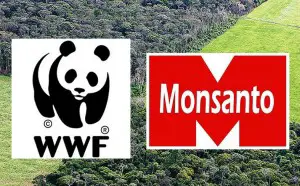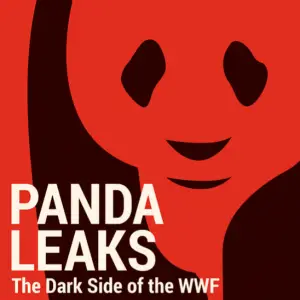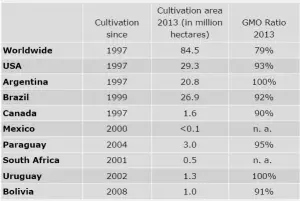
Is there a connection between the top wildlife conservation fund and Monsanto? The answer may surprise you.
In today’s day and age there are so many charities and foundations out there that choosing the right ones to support, and to trust for that matter, can be especially problematic.
A lot of people just give to the ones that are best known like the WWF, Susan G. Komen and others without knowing where their money really goes.
While most charities do their fair share of good work, they also can have plenty of dark secrets.
Some are money hoarders whose CEOs bring home the big bucks while spending comparatively little on research or actual work on the ground.
Others are simply too bloated and internally divided to be effective.
And still others have been getting away with far worse: they spend their time fraternizing with the enemies causing the very same problems they’ve been been supposedly working to solve for decades.
The WWF-Monsanto Connection
With its signature panda logo and history of doing good work on behalf of animal welfare across the globe, the World Wildlife Fund For Nature (WWF) has become one of the most recognizable charities of all-time.
Started in 1961, its stated mission is to conserve ecologically important regions and their wildlife.
But if that’s their true aim, then why has the WWF partnered with one of the most notorious nature killers in the world, Monsanto, whose products have been blamed for widespread monarch butterfly and honeybee deaths?
The world’s favorite wildlife charity was called out in a recent book titled ‘PandaLeaks: The Dark Side of the WWF,’ an exposé from German journalist and filmmaker Wilfried Huismann on everything from questionably high salaries to the organization’s ties to — you guessed it — the Big “M,” agrochemical giant Monsanto.
The book was a sequel of sorts to Huismann’s documentary ‘The Silence of the Pandas’ about the skeleton’s in the WWF’s closet.

A book titled ‘PandaLeaks: The Dark Side of the WWF’ was released in fall 2014. Click here to learn more.
The book immediately became a best-seller when it hit store shelves in 2012, but it almost never even saw the light of day because of opposition by the WWF’s legal team.
Terrified of the allegations within linking them to everything from commando hit squads in Africa to promoting Monsanto’s GMO crops, the WWF managed to stop the sale of the book for several weeks due to a massive campaign.
A series of lawsuits followed, but they were ultimately unable to prevent Huismann’s controversial book from being released.
Contained within the book within is a cavalcade of secrets including WWF’s relationship with Monsanto, whom the WWF admitted they took money from according to one German newspaper.
As stated on the website GMWatch, the friendly panda logo-clad charity actually collaborated with Monsanto to create something called the “Round Table on Responsible Soy.”
The campaign has been criticized as being a covert exercise in Monsanto’s patented brand of “greenwashing,” which calls GMO soy a “responsible” choice for protecting the environment despite much independent evidence to the contrary.
In other words, the countless people across the world who donate 20 bucks or more per month to the WWF are actually funding a charity with ties to what many call the most evil corporation in the world.
Despite mass protests, the WWF has refused to back down from their support of Monsanto’s genetically engineered soy and continues to post the Monsanto-approved campaign on its website.
GMO Soy: A Grave Threat to the Amazon Rainforest
While most GMO crops are grown in just six countries, two South American giants, Brazil and Argentina, have become hotbeds for soy production, with most of it being grown with genetically modified seeds from Monsanto and other companies.
The native Amazon Rainforest and other lands have suffered at the hands of the GMO soy boom: between 2007 and 2008 almost 3 million acres of the Brazilian Amazon rainforest was destroyed because of illegal logging, soy plantations and cattle ranching.
The grave situation led to a documentary release by Greenpeace titled ‘Soy: In the Name of Progress’ which you can watch at the bottom of this article.
According to the chart below from GMO Compass, Brazil’s soy industry has been virtually taken over by GMOs, which critics say threaten biodiversity in the rich and vitally important Amazon Rainforest.

Cultivation of GMO soy worldwide according to GMO Compass. Brazil is now at 90+% with much of it threatening biodiversity in the Amazon Rainforest.
The clearing of new areas of rainforest land for GMO soy has decreased in recent years thanks in large part to grassroots boycotts, but large-scale plantings have continued, as soy is especially valuable for use in feed for chickens, cows and other animals that are consumed for food.
Spreading the Word: WWF and Monsanto
So, what can we do?
For now, the best option is to spread the word and expose the truth, in hopes of a day when we can actually trust our charities to do the right thing.
If you support WWF with your dollars or know anyone else who does, please share this article and consider finding another way to help make a difference.
We need all the help we can get, that much is for sure.
Thanks for installing the Bottom of every post plugin by Corey Salzano. Contact me if you need custom WordPress plugins or website design.




